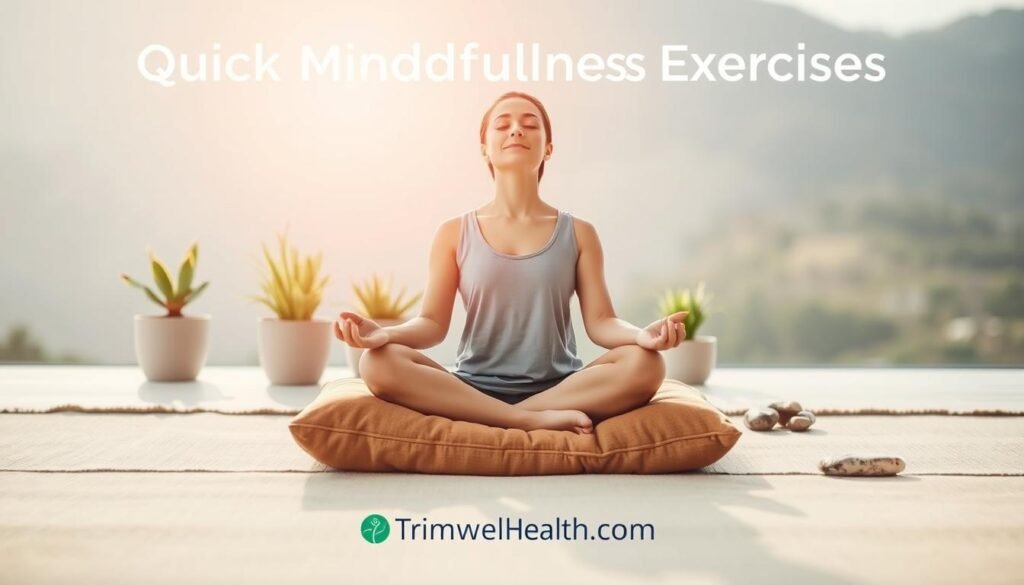Simple Mindfulness Rituals for Busy People
Imagine starting your day in a rush. You’re juggling breakfast, emails, and your to-do list. It feels like there’s no time to breathe or think.
But, adding simple mindfulness rituals to your day can change everything. Just a minute or two of focusing on your breath can help. These quick exercises bring balance to your busy life.
Mindfulness doesn’t take up a lot of time. It’s about finding small moments of peace in your day. These rituals can be made just for you, making them more personal and effective.
Discover how these strategies can be your own peaceful spot in a fast world. For more tips, check out this guide on mindfulness rituals for busy.
Key Takeaways
- Simple mindfulness rituals for busy people can be easily woven into daily schedules.
- Quick mindfulness exercises provide significant emotional and mental relief.
- Tailoring mindfulness practices enhances their effectiveness.
- Spending just minutes on mindfulness can lead to long-term wellbeing.
- Breathing techniques and progressive relaxation are effective stress relief methods.
Understanding Mindfulness and Its Importance
Mindfulness is key for good mental health and feeling calm. It means being fully in the moment without judging. It helps us know our thoughts, feelings, and what’s around us better.
Defining Mindfulness
Mindfulness is about paying attention to now. It helps us see things clearly without getting distracted. This makes our minds clearer and our feelings better.
The Benefits of Mindfulness for Busy Lifestyles
Mindfulness is great for those who are always busy. It lowers stress and anxiety, helps us focus, and makes us happier. It helps us handle daily life better, making us more productive and balanced.
Simple Mindfulness Rituals for Busy People
Finding time for self-care can be hard in today’s fast world. Simple mindfulness rituals offer a quick break. They help clear your mind and focus. You can add them to short breaks or when you’re moving around.
Quick Techniques to Integrate into Your Day
There are many quick techniques you can use. Try these in your daily life:
- Mindful breathing exercises
- Short moments of meditation
- Sensory grounding exercises
These techniques remind you to connect with yourself. A few deep breaths can calm you down. This makes it easier to deal with a busy day.
Customizing Your Mindfulness Practices
What works for you might not work for others. It’s important to find what you like. Trying different rituals helps you find what’s best. This makes your mindfulness journey more rewarding.
Utilizing Breathing Techniques for Immediate Calm
Using breathing techniques can really help your mood. The 4-7-8 method is great for feeling calm and less stressed. It’s perfect for busy people who need a break.
The 4-7-8 Breathing Method Explained
The 4-7-8 method is easy and can be done anywhere. You breathe in for 4 seconds, hold for 7, and breathe out for 8. This helps you relax and feel less stressed.
It’s great for anyone dealing with daily stress. It helps you calm down and focus.
Benefits of Controlled Breathing
Controlled breathing has many good points. It helps with stress and anxiety. Here are some benefits:
- Reduces anxiety and stress.
- Helps you feel emotionally balanced and clear-minded.
- Makes you better at concentrating and doing tasks.
- Helps control how you feel in tough situations.
Using the 4-7-8 method every day can make you feel better. It helps you stay calm, even when things are crazy. Doing it often can make you feel better for a long time.
Progressive Muscle Relaxation as a Stress-Relief Activity
Progressive muscle relaxation is a great way to relax when you’re busy. It helps you tense and then relax different muscles. This makes your body feel better and your mind clearer.
Learning how to do this can make you feel more calm. It’s a simple way to find peace in a busy world.
How to Perform Progressive Muscle Relaxation
To start, find a quiet spot to sit or lie down. Here’s what to do:
- Begin with your feet. Hold the muscles tight for five seconds, then relax for 30 seconds. Feel the difference.
- Next, tense your calf muscles and then relax them.
- Keep going up your body, tensing and relaxing each muscle group.
- After you’ve done all the groups, take a few minutes to relax and enjoy the calm.
Physical and Mental Benefits of This Technique
This technique does more than just relax your muscles. It also helps you feel your body better. Doing it often can help you handle stress better.
People say they feel less stressed and more calm after doing it. It’s a simple way to deal with life’s pressures.
Incorporating Sensory Grounding Exercises
Sensory grounding exercises help you stay in the moment. They make you feel better emotionally. The five senses method is a great way to do this.
It makes you notice what you see, hear, touch, smell, and taste. This helps you be mindful every day.
The Five Senses Method: How It Works
The five senses method is a simple way to ground yourself. Here’s how to do it:
- Identify five things you can see.
- List four things you can hear.
- Touch three different objects around you.
- Recognize two scents in your environment.
- Focus on one thing you can taste.
This exercise helps you feel connected to the world. It stops bad thoughts and brings calm when you’re stressed.
Reconnecting with Your Environment
Doing sensory exercises makes you more aware of now. It helps with anxiety and connects you to your surroundings. You can do it anywhere.
It brings peace and focus. Adding it to your daily life is good for your health. Learn more about mindfulness here.
Crafting a Personalized Daily Mindfulness Routine
Creating a mindfulness routine that’s just for you can really help. It’s about knowing what relaxes you. This way, you can make your practice fit your life better. Adding things that remind you to be mindful can also help a lot.
Identifying Your Relaxation Triggers
What relaxes you might be different for everyone. It could be sounds, smells, or things you do. Find out what calms you, like nature sounds or certain scents. Writing down what relaxes you can help a lot.
Creating Environmental Cues for Mindfulness
Setting up a special place for mindfulness can make a big difference. Make a quiet spot in your home for it. It should be calm and free from distractions.
Choose colors, smells, or music that are soothing. This way, every time you go there, you’ll feel calm and focused.

- Choose a consistent time each day for your practice.
- Incorporate your relaxation triggers into the space.
- Use your senses to reinforce calming associations.
Your mindfulness routine will grow and change over time. Keep checking what relaxes you and what makes your space calm. Enjoy the journey to finding peace within yourself.
Morning Mindfulness: Setting the Tone for the Day
Starting your day with mindfulness can change how you do things. A simple three-minute ritual can make mornings better. It helps you feel positive and get more done.
This practice makes mornings calm and focused. It’s a great way to begin your day.
Implementing a Three-Minute Morning Ritual
Adding a three-minute ritual is easy. You can breathe deeply, stretch, or write in a journal. Each action reminds you to be in the moment.
It’s a chance to take a break before the day starts. This short time helps you stay focused and clear.
The Impact of Gentle Mornings on Your Day
Gentle mornings make you feel better and more productive. Mindfulness in the morning lowers stress and boosts focus. This change helps your mind and heart feel good.
Starting with mindfulness makes your day smoother. It makes your day better in many ways.
Utilizing Mindfulness Apps for Busy Schedules
In today’s fast world, mindfulness apps are great tools. They help anyone add mindfulness to their busy lives. These apps fit into tight schedules, keeping mental health in check.
Recommended Apps to Enhance Your Practice
Many mindfulness apps are popular for their effectiveness. Here are a few to check out:
- Headspace: Offers guided meditations and sleep aids for busy lives.
- Calm: Has sessions for relaxation and focus, great for quick breaks.
- Sattva: Uses ancient wisdom for modern mindfulness, with guided meditations and daily inspirations.
- Insight Timer: A community app with thousands of free guided meditations to help your practice.
How Technology Can Support Mindfulness
Technology has changed how we care for our minds. Mindfulness apps send reminders and notifications. They offer sessions that fit your time and preferences.
This makes it easier to keep up with mindfulness. It helps you stay consistent in your practice.
Exploring Quick Mindfulness Exercises to Boost Productivity
Adding quick mindfulness exercises to your busy day can really help. Even short moments of mindfulness can refresh you, even on the busiest days.
Techniques That Fit into Short Breaks
Quick mindfulness exercises during breaks can clear your mind and improve focus. Here are some techniques to try:
- 1-Minute Breathwork: Spend one minute on your breath. Inhale for four counts, hold for four, and exhale for four. This calms your mind and helps you focus.
- Walking Meditations: Take a short walk, focusing on each step. Feel the ground, notice your surroundings, and live in the moment.
- Guided Visualization: Imagine a calm place, like a beach or forest. Spend a few moments in this peaceful scene.
Combining Mindfulness with Daily Tasks
Mindfulness with daily tasks can make your day better. Try these practices:
- Mindful Eating: Enjoy every bite at lunch or snack time. Notice the flavors and textures for a better experience.
- Engaged Conversations: Be fully there in talks. Listen well and think before you speak.
- Mindfulness in Routine Tasks: Focus on the feelings and actions when doing chores like washing dishes or folding laundry.

Mindfulness Tips to Overcome Common Barriers
Many people think they need a lot of time or a perfect place to start mindfulness. But, it’s not true. Using mindfulness tips can help you get past these thoughts and keep practicing.
Dispelling Myths About Mindfulness
It’s important to know that you don’t need hours or a perfect spot for mindfulness. Even a few minutes can help. Starting small and not needing to be perfect can make you more excited to try it.
Creating Consistency in Your Practice
Having a regular routine helps you stay consistent. Pick a time and place for mindfulness, even if it’s just a few minutes. Doing this regularly makes mindfulness easier to use in your life.
Measuring the Effectiveness of Your Mindfulness Rituals
It’s key to track how well your mindfulness rituals work. This helps you grow and understand yourself better. Seeing changes in stress and mood shows how well you’re doing. It keeps you going with these habits.
Tracking Changes in Stress Levels and Mood
To really see how mindfulness is changing you, try a few things:
- Daily Journaling: Write down your thoughts and feelings after each session.
- Mood Tracking Apps: Use apps to log and check your mood changes.
- Physical Indicators: Notice how your body feels, like energy or tiredness, and how it relates to stress.
Keeping track of stress and mood helps you see mindfulness’s impact. It makes you more committed to your practice.
Encouraging Long-Term Mindfulness Habit Formation
Creating lasting habits needs focus and looking back on your progress. Celebrate small wins. Look at your journal or app data to see what works for you. Here’s how:
- Set achievable goals: Start with short sessions and slowly make them longer.
- Establish a routine: Make mindfulness a regular part of your day.
- Engage with a community: Find groups or forums for mindfulness to get support and motivation.
By doing these things, mindfulness can become a lasting part of your life. It will make your life better overall.
Conclusion
Adding simple mindfulness rituals to our lives is key for our mental health and work. These habits help us find peace in the busy world. They include breathing exercises, quick activities, and being present in daily tasks.
Starting mindfulness might seem hard, but even short moments help a lot. Regular mindfulness builds emotional strength and reduces stress. It makes life better at work and home.
Embracing mindfulness leads to a more rewarding life. It changes how we live in many ways. For more tips and tools, see this mindfulness guide for busy folks.
FAQ
What is mindfulness?
Mindfulness is being fully present in the moment. It means not judging anything. It makes you feel calm and clear.
How can busy individuals integrate mindfulness into their routines?
Busy people can use short mindfulness breaks. Try quick breathing exercises or meditation during busy times.
What are some quick mindfulness exercises?
Quick exercises include the 4-7-8 breathing and muscle relaxation. You can also use the Five Senses Method. These take just a few minutes.
Are there any mindfulness apps that can help?
Yes, apps like Headspace and Calm are great. They offer guided meditations and reminders. They help you stay mindful with technology.
How can mindfulness improve productivity?
Mindfulness boosts focus and lowers stress. This makes you more productive. It helps you handle daily tasks better.
What is the 5 senses method in mindfulness?
The Five Senses Method focuses on your surroundings. Notice what you see, hear, touch, smell, and taste. It stops negative thoughts and brings calm.
How can I measure the effectiveness of my mindfulness practices?
Track your stress and mood after practicing. Keep a journal or use apps to see your progress.
What are some common myths about mindfulness?
Some think you need a lot of time or a perfect place. But, you can practice mindfulness in short times and anywhere.
How can I create a personalized mindfulness routine?
Find what relaxes you, like certain sounds or smells. Use these as cues. Set a special place for your mindfulness practice.
What are the benefits of the 4-7-8 breathing method?
The 4-7-8 breathing method lowers stress and brings calm. It helps with anxiety and keeps emotions balanced. It’s great for busy people.


